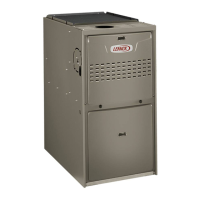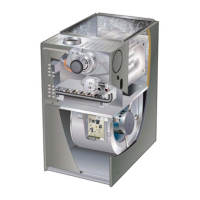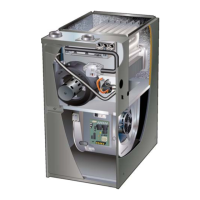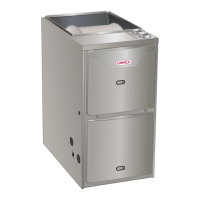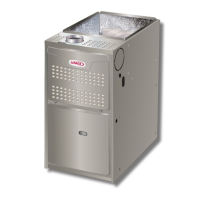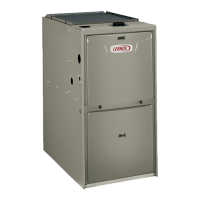Page 13
Venting Using a Masonry Chimney
The following additional requirements apply when a lined
masonry chimney is used to vent this furnace.
A chimney with one or more sides exposed to the outside
of the structure is considered to be an exterior chimney.
An exterior masonry chimney that is not tile-lined must be
An exterior tile-lined chimney that is sealed and capped
If the existing chimney will not accommodate a listed met-
al liner, either the chimney must be rebuilt to accommo-
date one of these liners or an alternate approved venting
method must be found.
-
Common Venting Using Metal-Lined Masonry Chimney
4 in. (102 mm)
minimum
MIN. LENGTH -- AS
SHORT AS PRACTICAL
MAX. LENGTH
-- SEE NOTE 1
BELOW.
SEALED
PERMANENTLY
SEALED FIREPLACE
OPENING
EXTERIOR
CHIMNEY WITH
METAL
LINER
VENT CONNECTOR
NOTE 1 - Refer to the provided venting tables for installations. Refer
to the capacity requirements shown in the provided venting tables.
OTHER
APPLIANCE
FURNACE
5 ft. (1.5 m)
minimum
AIR FLOW
Figure 17
DO NOT insulate the space between the liner and
the chimney wall with pued mica or any other loose
granular insulating material
IMPORTANT
SINGLE appliance venting of a fan-assisted furnace into
a tile-lined masonry chimney (interior or outside wall)
vent lining system which has been sized according to the
provided venting tables and the vent pipe manufacturer’s
instructions.
A fan-assisted furnace may be commonly vented into an
existing lined masonry chimney if the following conditions
are met:
• The chimney is currently serving at least one draft
hood equipped appliance
• The vent connectors and chimney are sized accord-
ing to the provided venting tables.
If type B1 double-wall vent is used inside a chimney, no
other appliance can be vented into the chimney. The out-
products.
A type B1 vent or masonry chimney liner shall terminate
above the roof surface with a listed cap or a listed roof as-
sembly according to the terms of their respective listings
and the vent manufacturer’s instructions.
When inspection reveals that an existing chimney is not
safe for the intended purpose, it shall be rebuilt to conform
to nationally recognized standards, lined or relined with
suitable materials, or replaced with a gas vent or chimney
suitable for venting ML180DFE series units. The chimney
passageway must be checked periodically to ensure that
it is clear and free of obstructions.
Do not install a manual damper, barometric draft regulator,
Never connect a Category I appliance to a chimney that is
be permanently sealed.
A type B or listed chimney lining system that passes
-
ered to be exposed to the outdoors.
General Venting Requirements
Vent all ML180DFE furnaces according to these instruc-
tions:
1 - Vent diameter recommendations and maximum
allowable piping runs are found in the provided
venting tables.
2 - In no case should the vent or vent connector diameter
venting tables.
3 - The minimum vent capacity determined by the sizing
the maximum vent capacity must be greater than the
4 - Single appliance vents - If the vertical vent or tile-
the vent connector, use the vertical vent diameter to
determine the minimum vent capacity and the vent
connector diameter to determine the maximum vent
appliance categorized vent area, drafthood outlet
approved engineering methods.
section of vertical vent or chimney shall not exceed
7 times the smallest listed appliance categorized
unless designed according to approved engineering
methods.
6 - The entire length of single wall metal vent connector
shall be readily accessible for inspection, cleaning,
and replacement.

